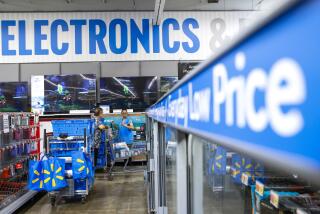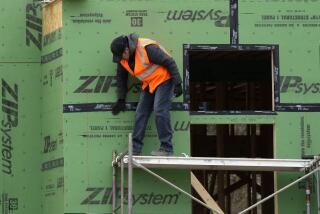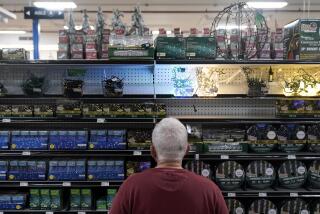U.S. Factory Orders Headed South in June : Economy: First-time jobless claims tumble. Retailers posted modest sales gains in July.
- Share via
WASHINGTON — Orders to U.S. factories slipped 0.2% in June, the fourth decline in five months, the Commerce Department reported Thursday.
The retreat was led by a plunge in orders for electronic equipment and highly volatile demand for aircraft, the government said. Excluding transportation goods, orders fell 0.1% in June after climbing 1.1% in May.
In other economic news:
* The Labor Department reported that the number of American workers filing first-time claims for jobless benefits fell by 51,000 last week to 321,000, the largest drop in a year and the latest sign that seasonal layoffs had ended.
* Retailers posted only modest sales gains in July as consumers continued to spend cautiously, the nation’s large store chains reported. Last month’s heat wave helped some, stoking sales of air conditioners.
Analysts had expected factory orders to remain flat in June after gaining 2.5% in May. The slight decline in June confirms sluggishness in manufacturing as businesses trim inventories that accumulated earlier this year.
Before the May advance, factory orders had fallen for three straight months for the first time in two years.
Weakness in manufacturing has contributed to the economy’s dramatic slowdown this year, but there also have been recent signs of modest recovery.
Despite the weak showing for factory orders, they are still running 8.3% above the first half of last year.
The decline in June orders included a 3.3% drop in electronic equipment and a 1.2% fall in transportation equipment. Orders for transportation equipment had surged 3% in May.
Orders for all durable goods, or big-ticket items expected to last at least three years, slipped 0.3%.
Non-durable goods orders, including food and fuel, fell 0.2%.
Overall, factory orders in June totaled a seasonally adjusted $296.4 billion, down from $297 billion in May.
In the Labor Department report, the government said unemployment claims for the week ended July 29 tumbled as auto and textile workers returned to work from temporary layoffs.
The decline brought claims to their lowest level since 319,000 in the week ended Feb. 4.
The drop was far larger than expected by economists, who had predicted new claims would total 371,000.
“It’s good news,” said James Glassman, an economist at Chemical Securities. “However you look at it, it looks like employment has stopped contracting and may be expanding.”
The number of people receiving state unemployment benefits in the week ended July 22, the latest period for which the figures were available, tumbled to 2.66 million from a revised 2.78 million the previous week.
Meanwhile, while last month’s heat wave boosted sales at large discounters and department stores, several clothing store giants such as Limited Inc. and Gap Inc. posted declines.
Limited’s sales fell 3% in July and Gap receipts were down 6%.
Chicago-based Sears, Roebuck & Co., the nation’s third-largest retailer, posted a 6% increase in same-store sales, a measure of sales among stores open at least a year.
Sears said it sold a record number of air conditioners during July. So far this year, its air-conditioner sales have outstripped the record sales for all of 1994.
Wal-Mart Stores Inc., the nation’s leading retailer, said same-store sales rose 4.9%, and Kmart Corp., which ranks second, posted a 5.6% gain.
“July was one of the hottest months in history,” said Todd Slater of UBS Securities. “This was good for those who sold fans and air conditioners and bad for those who sell apparel.”
Overall sales rose, but not as robustly as Wall Street anticipated, analysts said.
(BEGIN TEXT OF INFOBOX / INFOGRAPHIC)
Factory Orders
Toal new orders, seasonally adjsuted, billions of dollars:
January 1995: $296.4
More to Read
Inside the business of entertainment
The Wide Shot brings you news, analysis and insights on everything from streaming wars to production — and what it all means for the future.
You may occasionally receive promotional content from the Los Angeles Times.










